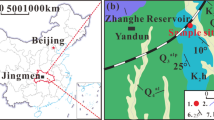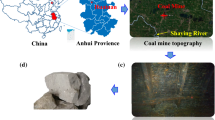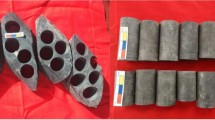Abstract
The disintegration of carbonaceous mudstone under the recurring action of acid rain increases the risk of geohazard occurrence. In this paper, a series of disintegration tests were conducted at pH values of 1, 3, 5, and 7 to investigate the disintegration behavior and disintegration mechanism of carbonaceous mudstone under acidic corrosion and wetting-drying cycles. The disintegration process can be divided into three stages (e.g., water absorption saturation, fracture expansion, and surface exfoliation). With the increase of wetting-drying cycles, the particle size of carbonaceous mudstone gradually decreases, and the particle size gradation curve of carbonaceous mudstone after disintegration is S-shaped, which is consistent with Weibull function distribution. A smaller value of the Weibull model parameter λ (the scale parameter) results in a smaller average particle size of the carbonaceous mudstone disintegration products, and the value of k (the shape parameter) reveals the degree of drastic change in the grain gradation of carbonaceous mudstone k and λ together reflect the rate of carbonaceous mudstone disintegration. A smaller decrease in the disintegration ratio and decreasing rate is observed with an increase in the number of wetting-drying cycles. The disintegration ratios of carbonaceous mudstone under the four pH conditions from largest to smallest are pH = 7 > pH = 5 > pH = 3 > pH = 1. The disintegration of carbonaceous mudstone is mainly caused by hydration-swelling, adsorption-fracturing, and dissolution-erosion. The presence of acid promotes the dissolution-erosion of carbonate in carbonaceous mudstones, which in turn accelerates the hydration-swelling and adsorption-fracturing as well as the disintegration ratio of carbonaceous mudstones.

















Similar content being viewed by others
Data availability
The data used to support the findings of this study are available from the corresponding author upon request.
References
Ajmal M, Danish MY, Arshad IA (2022) Objective Bayesian analysis for Weibull distribution with application to random censorship model. J Stat Comput Sim 92(1):43–59. https://doi.org/10.1080/00949655.2021.1931210
Al-Balushi MA, Karimi M, Al-Maamari RS (2019) Impact of acid and base numbers and their ratios on wettability alteration of the calcite surface. Energ Fuel 34(1):245–257. https://doi.org/10.1021/acs.energyfuels.9b03538
Al-Dossary AA, Awed AM, Gabr AR, Fattah MY, El-Badawy SM (2023) Performance enhancement of road base material using calcium carbide residue and sulfonic acid dilution as a geopolymer stabilizer. Constr Build Mater 364:129959. https://doi.org/10.1016/j.conbuildmat.2022.129959
Amorim CLG, Lopes RT, Barroso RC, Queiroz JC, Alves DB, Perez CA, Schelin HR (2007) Effect of clay–water interactions on clay swelling by X-ray diffraction. Nucl Instrum Methods Phys Res, Sect A 580(1):768–770. https://doi.org/10.1016/j.nima.2007.05.103
Anderson RL, Ratcliffe I, Greenwell HC, Williams PA, Cliffe S, Coveney PV (2010) Clay swelling–a challenge in the oilfield. Earth-Sci Rev 98(3–4):201–216. https://doi.org/10.1016/j.earscirev.2009.11.003
ASTM D5313-12 (2013) Standard test method for evaluation of durability of rock for erosion control under wetting and drying conditions. ASTM International, West Conshohocken, PA
Badizad MH, Koleini MM, Greenwell HC, Ayatollahi S, Ghazanfari MH, Mohammadi M (2020) Ion-specific interactions at calcite–brine interfaces: a nano-scale study of the surface charge development and preferential binding of polar hydrocarbons. Phys Chem Chem Phys 22(48):27999–28011. https://doi.org/10.1039/D0CP04828C
Blackmore S, Vriens B, Sorensen M, Power IM, Smith L, Hallam SJ, Mayer KU, Beckie RD (2018) Microbial and geochemical controls on waste rock weathering and drainage quality. Sci Total Environ 640:1004–1014. https://doi.org/10.1016/j.scitotenv.2018.05.374
Çetintaş S, Akboğa Z (2020) Investigation of resistance to ageing by SO2 on some building stone. Constr Build Mater 262:120341. https://doi.org/10.1016/j.conbuildmat.2020.120341
Chen C, Peng S, Wu S, Xu J (2019) The effect of chemical erosion on mechanical properties and fracture of sandstone under shear loading: an experimental study. Sci Rep-UK 9(1):1–12. https://doi.org/10.1038/s41598-019-56196-2
Chen YRX, Wang XF, Huang L, Luo YL (2021) Spatial and temporal characteristics of abrupt heavy rainfall events over Southwest China during 1981–2017. Int J Climatol 41(5):3286–3299. https://doi.org/10.1002/joc.7019
Derkani MH, Fletcher AJ, Fedorov M, Abdallah W, Sauerer B, Anderson J, Zhang ZJ (2019) Mechanisms of surface charge modification of carbonates in aqueous electrolyte solutions. Colloids Interfaces 3(4):62. https://doi.org/10.3390/colloids3040062
Duan YR, Yang ZF, Yu T, Yang Q, Liu X, Ji WB, Jiang HY, Zhuo XX, Wu TS, Qin JX, Wang L (2020) Geogenic cadmium pollution in multi-medians caused by black shales in Luzhai, Guangxi. Environ Pollut 260:113905. https://doi.org/10.1016/j.envpol.2019.113905
Erami FE, Firoozjaee AR (2020) Numerical solution of bed load transport equations using discrete least squares meshless (DLSM) method. Appl Math Model 77:1095–1109. https://doi.org/10.1016/j.apm.2019.08.016
Erguler ZA, Ulusay R (2009) Assessment of physical disintegration characteristics of clay-bearing rocks: disintegration index test and a new durability classification chart. Eng Geol 105(1–2):11–19. https://doi.org/10.1016/j.enggeo.2008.12.013
Fang ZG, Patterson BR, Turner JME (1993) Modeling particle size distributions by the Weibull distribution function. Mater Charact 31(3):177–182. https://doi.org/10.1016/1044-5803(93)90058-4
Fattah MY, Al-Ani MM, Al-Lamy MT (2015) Wetting and drying collapse behaviour of collapsible gypseous soils treated by grouting. Arab J Geosci 8:2035–2049. https://doi.org/10.1007/s12517-014-1329-7
Gentzis T, Carvajal-Ortiz H, Selim SS, Tahoun SS, El-Shafeiy M, Ocubalidet S, Ali AAM (2018) Depositional environment and characteristics of Late Eocene carbonaceous swampy tidal flat facies in the Fayoum Basin, Egypt. Int J Coal Geol 200:45–58. https://doi.org/10.1016/j.coal.2018.10.008
Gibeaux S, Vázquez P, De Kock T, Cnudde V, Thomachot-Schneider C (2018) Weathering assessment under X-ray tomography of building stones exposed to acid atmospheres at current pollution rate. Constr Build Mater 168:187–198. https://doi.org/10.1016/j.conbuildmat.2018.02.120
Han TL, Wang XF, Li ZH, Li DW, Xing FW, Han NX (2020) Laboratory investigation of the mode-I fracture of sandstone caused by a combination of freeze-thaw cycles and chemical solutions. Bull Eng Geol Environ 79:3689–3706. https://doi.org/10.1007/s10064-020-01762-6
He JY, Leng YY, Wu Y, Chang WB, Zhuang Y, Zou FC (2022) Slaking and disintegration behavior of mudstone: insights from laboratory experiment and orthogonal images. Bull Eng Geol Environ 81(7):277. https://doi.org/10.1007/s10064-022-02778-w
Huang TM, Fan YF, Long Y, Pang ZH (2019) Quantitative calculation for the contribution of acid rain to carbonate weathering. J Hydrol 568:360–371. https://doi.org/10.1016/j.jhydrol.2018.11.003
Kasha A, Al-Hashim H, Abdallah W, Taherian R, Sauerer B (2015) Effect of Ca2+, Mg2+ and SO42− ions on the zeta potential of calcite and dolomite particles aged with stearic acid. Colloid Surface A 482:290–299. https://doi.org/10.1016/j.colsurfa.2015.05.043
Kasha A, Sauerer B, Al-Hashim H, Abdallah W (2021) Interplay between Ca2+, Mg2+, and SO42–ions and their influence on the zeta-potential of limestone during controlled-salinity waterflooding. Energ Fuel 35(16):12982–12992. https://doi.org/10.1021/acs.energyfuels.1c00940
Li KP, Zhao XY, Xiao D (2021) Acid rain: an unsuspected factor predisposing Panzhihua airport landslide, China. Environ Sci Pollut R 28:36753–36764. https://doi.org/10.1007/s11356-021-13308-8
Liu Y, Yang FW, Zuo GF, Zhang RX, Wei GF, Ma Q (2018) Protection of the surface weathering stone artworks by a chemical conversion method. Constr Build Mater 182:210–214. https://doi.org/10.1016/j.conbuildmat.2018.06.108
Liu W, Song X, Huang F, Hu L (2019) Experimental study on the disintegration of granite residual soil under the combined influence of wetting-drying cycles and acid rain. Geomat Nat Haz Risk 10(1):1912–1927. https://doi.org/10.1080/19475705.2019.1651407
Lu X, Zhang SJ, Xing J, Wang YJ, Chen WH, Ding D, Wu Y, Wang SX, Duan L, Hao JM (2020) Progress of air pollution control in China and its challenges and opportunities in the ecological civilization era. Engineering-PRC 6(12):1423–1431. https://doi.org/10.1016/j.eng.2020.03.014
Lü WW, Yao X, Su CT, Ren HY, Yao M, Zhang BH (2020) Characteristics and influencing factors of hydrochemistry and dissolved organic matter in typical karst water system. Environ Sci Pollut R 27(10):11174–11183. https://doi.org/10.1007/s11356-019-07227-y
Mahdikhani M, Bamshad O, Shirvani MF (2018) Mechanical properties and durability of concrete specimens containing nano silica in sulfuric acid rain condition. Constr Build Mater 167:929–935. https://doi.org/10.1016/j.conbuildmat.2018.01.137
Marouf R, Marouf-Khelifa K, Schott J, Khelifa A (2009) Zeta potential study of thermally treated dolomite samples in electrolyte solutions. Micropor Mesopor Mat 122(1–3):99–104. https://doi.org/10.1016/j.micromeso.2009.02.021
Milakovska Z, Stefanova M, Vladislavov G, Marinov SP (2021) Geochemical features of altered carbonaceous mudstones from Troyanovo-3 Mine borehole (Maritsa Iztok lignite field, Bulgaria). Org Geochem 96:1–10. https://doi.org/10.1016/j.coal.2022.104058
Monfared AD, Ghazanfari MH, Jamialahmadi M, Helalizadeh A (2015) Adsorption of silica nanoparticles onto calcite: equilibrium, kinetic, thermodynamic and DLVO analysis. Chem Eng J 281:334–344. https://doi.org/10.1016/j.cej.2015.06.104
Norrish K (1954) The swelling of montmorillonite. Discuss Faraday Soc 18:120–134. https://doi.org/10.1039/DF9541800120
Oakland MW, Lovell CW (1982) Standardized tests for compacted shale highway embankments. Transport Res Rec 873:15–22
Qin NX, Wang JN, Gao L, Hong Y, Huang JL, Lu QQ (2021) Observed trends of different rainfall intensities and the associated spatiotemporal variations during 1958–2016 in Guangxi, China. Int J Climatol 41:2880–2895. https://doi.org/10.1002/joc.6888
Shi J, Zhao JG, Chen H, Hou PK, Kawashima S, Qin JH, Zhou XM, Qian JS, Cheng X (2022) Sulfuric acid-resistance performances of magnesium phosphate cements: macro-properties, mineralogy and microstructure evolutions. Cement Concrete Res 157:106830. https://doi.org/10.1016/j.cemconres.2022.106830
Su X, Tang H, Huang L, Shen P, Xia D (2020) The role of pH in red-stratum mudstone disintegration in the Three Gorges reservoir area, China, and the associated micromechanisms. Eng Geol 279:105873. https://doi.org/10.1016/j.enggeo.2020.105873
Wang HL, Yang J, Zha HY, Fu HY, Zhu XB, Jia CK (2022) The use of artemisia sphaerocephala Krasch. gum as an eco-friendly stabilizer to improve the mechanical properties of disintegrated carbonaceous mudstone. Constr Build Mater 316:125833. https://doi.org/10.1016/j.conbuildmat.2021.125833
Xiao D, Zhao XY, Li KP, Zhao XC, Liu HW, Li X, Luo G (2021) Influence of acid rain on slope instability mechanism–a case study in Sichuan provincial highway, China. Bull Eng Geol Environ 80(5):3659–3673. https://doi.org/10.1007/s10064-021-02170-0
Xu D, Wu Y, Cao KW, Muhammad Khan N, Hussain S, Lee S, Ma C (2021) Analysis of mudstone fracture and precursory characteristics after corrosion of acidic solution based on dissipative strain energy. Sustainability-Basel 13(8):4478. https://doi.org/10.3390/su13084478
Yan LB, Liu P, Peng H, Kašanin-Grubin M, Lin K (2019) Laboratory study of the effect of temperature difference on the disintegration of redbed softrock. Phys Geogr 40(2):149–163. https://doi.org/10.1080/02723646.2018.1559418
Yan ZL, Han XK, Lang YC, Guo QJ, Li SL (2020) The abatement of acid rain in Guizhou province, southwestern China: implication from sulfur and oxygen isotopes. Environ Pollut 267:115444. https://doi.org/10.1016/j.envpol.2020.115444
Yang HJ, Wei FQ, Ma ZF, Guo HY, Su PC, Zhang SJ (2020) Rainfall threshold for landslide activity in Dazhou, southwest China. Landslides 17(1):61–77. https://doi.org/10.1007/s10346-019-01270-z
Zeng L, Luo JT, Liu J, Gao QF, Bian HB (2021a) Disintegration characteristics and mechanisms of carbonaceous mudstone subjected to load and cyclic drying-wetting. J Mater Civil Eng 33(8):04021195. https://doi.org/10.1061/(ASCE)MT.1943-5533.0003817
Zeng L, Yu HC, Liu J, Gao QF, Bian HB (2021b) Mechanical behaviour of disintegrated carbonaceous mudstone under stress and cyclic drying/wetting. Constr Build Mater 282:122656. https://doi.org/10.1016/j.conbuildmat.2021.122656
Zeng L, Zha HY, Gao QF (2021c) Optimal design of mixing ratios of modifiers for disintegrated carbonaceous mudstone. Geomech Eng 26(4):401–413. https://doi.org/10.12989/gae.2021.26.4.401
Zha HY, Fu HY, Zeng L, Zhu XB, Jia CK (2022) Use of sodium alginate as a novel cementitious material to improve the engineering properties of disintegrated carbonaceous mudstone. Bull Eng Geol Environ 81(10):1–15. https://doi.org/10.1007/s10064-022-02936-0
Zhang ZT, Gao WH (2020) Effect of different test methods on the disintegration behaviour of soft rock and the evolution model of disintegration breakage under cyclic wetting and drying. Eng Geol 279:105888. https://doi.org/10.1016/j.enggeo.2020.105888
Zhang CL, Li ZY, Yang WW, Pan LP, Gu MH, Lee D (2013) Assessment of metals pollution on agricultural soil surrounding a lead–zinc mining area in the karst region of Guangxi, China. Bull Environ Contam Tox 90:736–741. https://doi.org/10.1007/s00128-013-0987-6
Zhang ZT, Gao WH, Zeng CF, Tang XY, Wu J (2020) Evolution of the disintegration breakage of red-bed soft rock using a logistic regression model. Transp Geotech 24:100382. https://doi.org/10.1016/j.trgeo.2020.100382
Zhao JX, Lu CH, Deng LM, Liu GC (2018a) Impacts of simulated acid solution on the disintegration and cation release of purple rock (mudstone) in Southwest China. Geomorphology 316:35–43. https://doi.org/10.1016/j.geomorph.2018.05.009
Zhao S, Liu S, Hou X, Cheng F, Wu X, Dong S, Beazley R (2018b) Temporal dynamics of SO2 and NOx pollution and contributions of driving forces in urban areas in China. Environ Pollut 242:239–248. https://doi.org/10.1016/j.envpol.2018.06.085
Zhu Z, Wang J, Hu M, Jia L (2019) Geographical detection of groundwater pollution vulnerability and hazard in karst areas of Guangxi Province, China. Environ Pollut 245:627–633. https://doi.org/10.1016/j.envpol.2018.10.017
Funding
This work was supported by the National Natural Science Foundation of China (Nos. 51838001, 51878070, 51878078 and 51678074), the Natural Science Foundation of Hunan Province, China (No. 2015JJ6004), and the Research and Development Projects in Key Fields of Hunan Province, China (No. 2019SK2171), Hunan Province Outstanding Youth Fund Project(No. 2023JJ10045).
Author information
Authors and Affiliations
Corresponding author
Ethics declarations
Conflict of interest
The authors declare no competing interests.
Rights and permissions
Springer Nature or its licensor (e.g. a society or other partner) holds exclusive rights to this article under a publishing agreement with the author(s) or other rightsholder(s); author self-archiving of the accepted manuscript version of this article is solely governed by the terms of such publishing agreement and applicable law.
About this article
Cite this article
Fu, Hy., Zha, HY., Zeng, L. et al. Disintegration behavior and mechanism of carbonaceous mudstone under acidic corrosion and wetting-drying cycles. Bull Eng Geol Environ 82, 168 (2023). https://doi.org/10.1007/s10064-023-03192-6
Received:
Accepted:
Published:
DOI: https://doi.org/10.1007/s10064-023-03192-6




